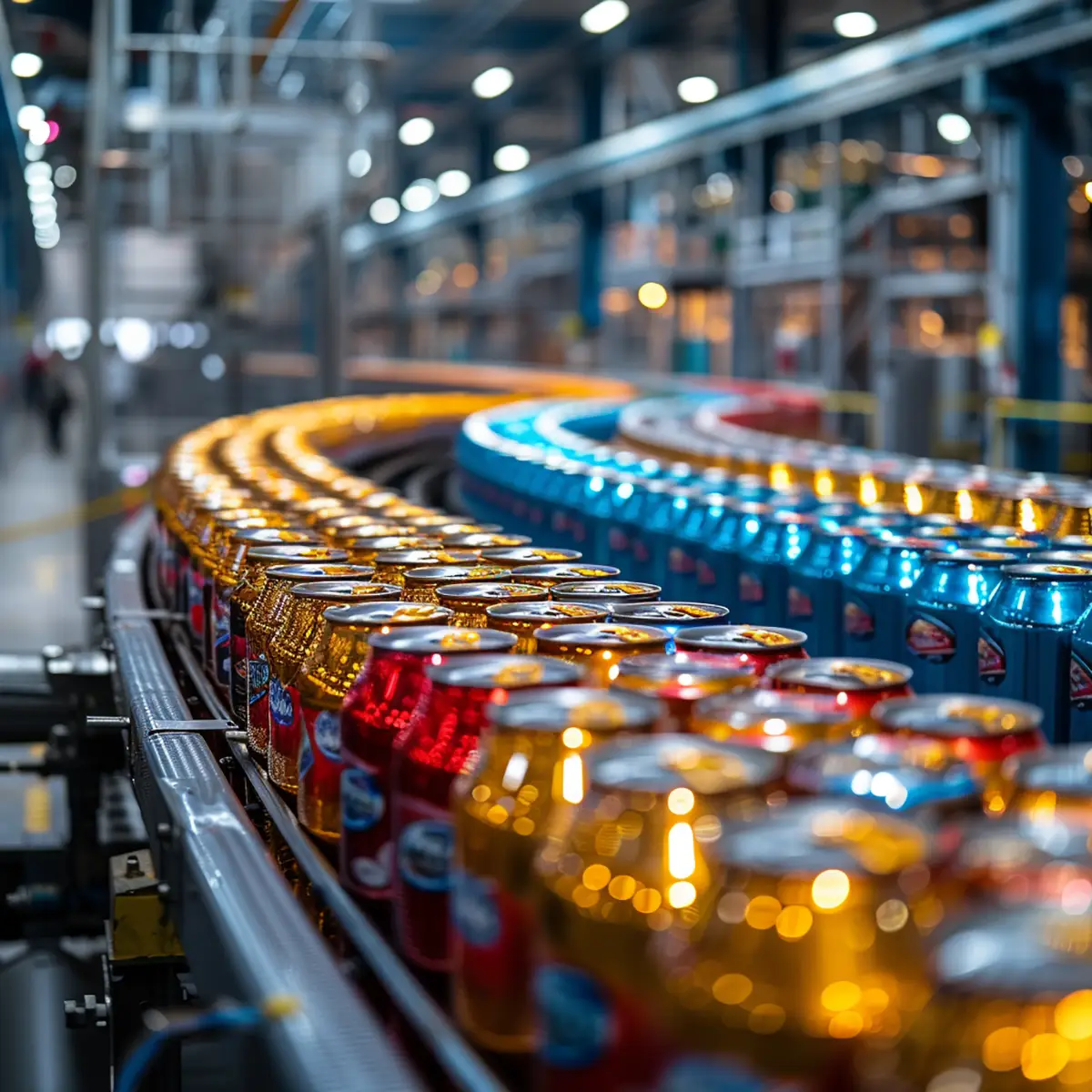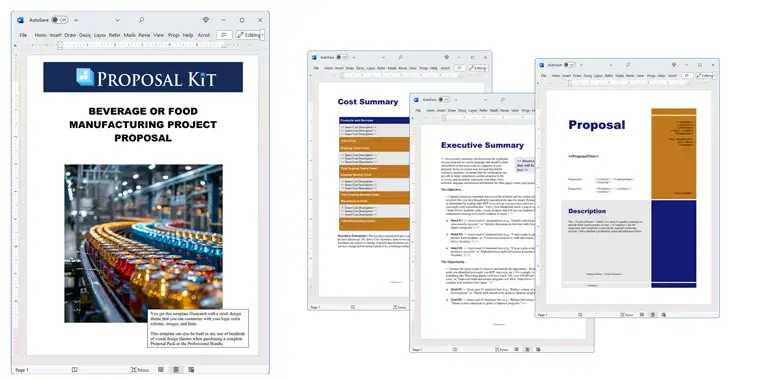How to write your Beverage or Food Manufacturing Project Proposal
We include this 26 page layout with every Proposal Pack. If you want this template to have a different visual design theme than the one illustrated here, purchase any Proposal Pack design and create this template using the purchased design theme. This template is included in every Proposal Pack. If you get a Proposal Pack or the Professional, you can also make any variation of this template with different chapters to suit your needs.
We typically include more chapters in the templates than most people will need to give everyone more variety in the chapters they may need. You can trim down a long template by removing pages you do not need or combining multiple chapter topics into one page.
 DOWNLOADABLE, ONE-TIME COST, NO SUBSCRIPTION FEES
DOWNLOADABLE, ONE-TIME COST, NO SUBSCRIPTION FEESYou can also create countless variations of this document to suit your needs using the included library of 2200+ chapters if ordering a Proposal Pack or Professional.
 What Our Clients Say
What Our Clients SayProposal Pack for Any Business and the Proposal Pack Wizard has been at the forefront of my business activities for over three years. No other product has contributed more to our successes and its ease of use a real time-saver."
Business Consultant
Related Article
Related Video
Related Templates
- Manufacturing Process Improvement Proposal
- Food and Beverage Seasonal Location Proposal
- Manufacturing and Distribution Proposal
- Relocate Manufacturing Domestic Proposal
- Beverage Distributor Product Sales Proposal
- Food Product Development Proposal
- Healthy Food and Beverage Product Pitch Proposal
- AI Powered Domestic Manufacturing Proposal Template
- Sanitary Transportation Food Safety Proposal
- Product Manufacturer Proposal
- Food Processing and Storage Services Proposal
- Nutritional Improvement Pilot Program Proposal
- New Product Idea Proposal
- Automation of Facilities and Production Proposal
- Collaborative Robotics Manufacturing Proposal Template
- Automation of Manufacturing Processes Proposal Template
- Food Kiosk Equipment Grant Proposal
- Shifting Production from Commercial to Consumer Proposal
- Advanced Manufacturing Proposal Template
- Retooling Production Line Proposal
- Outsource Supply Production Locally Proposal
- Intelligent Factory Reshoring RFP Template
- Product Manufacturing Project Proposal
- Manufacturing Proposal Template
- Site Safety Upgrades to Meet Regulations Proposal
Writing a Winning Beverage or Food Manufacturing Project Proposal with Proposal Kit
The ability to write a compelling and comprehensive business proposal is crucial. This task can be daunting, especially for those unfamiliar with proposal writing. Fortunately, Proposal Kit, with its extensive template library and Wizard software program, streamlines this process, making it accessible even to novices.
Can you see yourself in this scenario, needing to create a proposal for such projects?
Understanding the Proposal Kit Approach
A proven way to write a beverage or food manufacturing project proposal, particularly for those new to this process, is to utilize the Proposal Kit template library and Wizard software program. These tools simplify the proposal writing process by providing a structured approach. The template library includes a wide array of topics focusing on essential aspects such as health issues, regulations, manufacturing processes, facilities, distribution, warehousing, and more, tailored specifically for beverage and food manufacturing proposals.
The Proposal Kit also incorporates a comprehensive line item quoting database system. This feature is invaluable for creating detailed cost summaries, quotes, estimates, budgets, and other financial aspects of the proposal.
What Types of Projects Are Beverage or Food Manufacturing Project Proposals Written For?
Beverage and food manufacturing projects can vary widely. Here are some examples:
- Launching a new organic juice line.
- Expanding a craft brewery's production capacity.
- Developing a new frozen food product for retail.
- Implementing a sustainable packaging initiative for a snack food brand.
- Upgrading a confectionery factory's automation systems.
- Establishing a new distribution network for a dairy product line.
- Introducing a health-focused beverage into the market.
- Developing a gluten-free bakery product range.
- Creating a new line of gourmet sauces.
- Implementing an energy-efficient refrigeration system in a food processing plant.
Chapters this template is built with
The Proposal Kit's effectiveness lies in its ability to address specific needs through targeted templates. Consider these key chapters and how they apply.
Incorporating pages such as these effectively in your proposal using Proposal Kit not only demonstrates thorough planning and professionalism but also significantly enhances the likelihood of your project's success in the competitive beverage and food manufacturing industry.
Executive Summary
This section is crucial as it offers a concise overview of your entire proposal. It highlights the primary goals, the expected impact of your project, and why it stands out. For a beverage or food manufacturing proposal, this might include an introduction to your unique product, its market relevance, and the anticipated benefits it brings to the consumer market.
Cost Summary
Here, you detail all the financial aspects of your project. This includes the initial investment, ongoing operational costs, and projected returns. In the context of food or beverage manufacturing, it may encompass equipment costs, raw materials, labor, and transportation. Transparency in this section builds trust and aids in securing funding or approval.
Production Plan
This section outlines the process of product creation, from raw material sourcing to final production. It should include timelines, stages of production, and resource allocation. For a beverage or food product, detailing the manufacturing process, quality assurance steps, and packaging procedures are essential.
Marketing Plan
A vital component that describes how you will promote your product. This should include market analysis, target demographics, branding strategies, advertising channels, and sales forecasts. For food and beverage products, emphasizing unique selling points and compliance with consumer trends is crucial.
Warehousing
In this part, you address the storage requirements for your products, considering factors like shelf life, temperature control, and logistics. It's important to outline how warehousing solutions will support efficient distribution and maintain product quality.
Automation
Here, focus on how technology and automation will be integrated into your manufacturing process. This could involve automated production lines, robotics, and software systems for inventory management. Automation can significantly enhance efficiency and consistency in food and beverage manufacturing.
Sanitation
A critical section, especially in food and beverage manufacturing, highlighting health and safety protocols. This includes cleanliness standards, waste management, and adherence to hygiene regulations, ensuring product safety and consumer trust.
Regulations
This section ensures your proposal complies with relevant industry standards and legal requirements. It should detail how your product meets food safety laws, labeling standards, and environmental regulations, essential for market approval.
Infrastructure
Discusses the physical and organizational structures necessary for your project. This might include the manufacturing facilities, equipment needed, transportation logistics, and staffing requirements, laying the foundation for efficient production and distribution.
Packaging
Focuses on the design and sustainability of your product packaging. This includes materials used, branding elements, environmental impact, and how packaging contributes to product appeal and shelf life.
Brand Development
Explores how you plan to develop and position your brand in the market. This involves creating a brand identity, establishing a brand voice, and strategies for building brand loyalty among your target audience.
Capacity
Addresses the production volume and scalability of your manufacturing process. This includes current capabilities and plans for scaling up production in response to market demand, ensuring long-term sustainability and growth.
Distribution
Plans the logistics of getting your products to the market. This encompasses distribution channels, transportation methods, and strategies to ensure timely and efficient delivery of your products to retailers or directly to consumers.
Suppliers
Identifies and evaluates potential partners for sourcing raw materials and other essential inputs. This section emphasizes the importance of reliable suppliers for maintaining product quality and uninterrupted production.
Quality Control
This is paramount, ensuring that your product consistently meets predefined standards and regulatory requirements. It involves setting quality benchmarks, testing procedures, and measures for continuous improvement, critical for maintaining consumer trust and brand reputation.
Use cases for this template
Emily's Start-Up Journey
Emily, a small business owner, dreams of launching her line of herbal teas. Facing the challenge of writing a proposal, she turns to Proposal Kit. The software's intuitive design and comprehensive templates enable Emily to develop a robust plan covering everything from production to marketing. The cost summary feature proves particularly beneficial, helping her outline her budget effectively.
David's Tight Deadline Achievement
David, an employee at a large beverage company, is tasked with proposing a new line of energy drinks. With a tight deadline, he accomplishes his task with Proposal Kit. Its pre-structured layouts and industry-specific templates allow him to quickly assemble a persuasive proposal, impressing his superiors and meeting his deadline with ease.
Sarah's Celebrity-Backed Venture
Sarah, working for a celebrity-backed venture, needs to pitch a unique beverage concept. Proposal Kit's customization options enable her to write a proposal that resonates with the glamour and uniqueness of the celebrity world, balancing financial details with creative marketing strategies.
Conclusions and Recommendations
Each of these stories underscores the transformative power of the Proposal Kit in addressing specific needs in beverage and food manufacturing proposals. From Emily's small startup to David's corporate challenge and Sarah's high-profile project, the Proposal Kit provides a structured, comprehensive, and accessible solution for writing winning proposals.
By harnessing the power of Proposal Kit, individuals and businesses can navigate the complexities of proposal writing, ensuring their ideas are presented in a clear, professional, and persuasive manner. Whether you are launching a new product, expanding production, or pitching to investors, Proposal Kit is an invaluable tool in your journey to success in the beverage and food manufacturing industry.
Also Known As
This template may also be referred to in different ways or be used in more specialized situations, such as:
- Food and Beverage Production Initiative Plan
- Culinary Manufacturing Project Blueprint
- Nutritional Product Development Proposal
- Refreshment Production Strategy Outline
- Edible Goods Manufacturing Project Submission
- Beverage and Food Processing Scheme
- Gastronomic Production Enhancement Proposal
- Consumer Goods Manufacturing Strategy Document
- Sustainable Food Production Project Draft
- Gourmet Product Launch Plan
Abstract
 Creating a proposal in the food and beverage business can be a complex task, yet it is important for achieving success in the beverage manufacturing industry. With the Proposal Kit's comprehensive templates and Wizard software, both experienced developers and novices can produce detailed proposals for food and beverage management projects. The program covers a wide range of topics, from production space requirements to customer satisfaction strategies, helping businesses define their business model and manage contamination risks. These templates provide structural support, allowing firms to navigate the intricacies of beverage processing, procurement of new equipment, and adherence to safety standards, thus ensuring a consistent final product that aligns with increased interest in the market.
Creating a proposal in the food and beverage business can be a complex task, yet it is important for achieving success in the beverage manufacturing industry. With the Proposal Kit's comprehensive templates and Wizard software, both experienced developers and novices can produce detailed proposals for food and beverage management projects. The program covers a wide range of topics, from production space requirements to customer satisfaction strategies, helping businesses define their business model and manage contamination risks. These templates provide structural support, allowing firms to navigate the intricacies of beverage processing, procurement of new equipment, and adherence to safety standards, thus ensuring a consistent final product that aligns with increased interest in the market.
Considering the beverage business situation, having a well-prepared proposal is crucial for navigating the first round of stakeholder meetings. The Proposal Kit facilitates this by organizing each project phase, from assessing the current situation to achieving future goals. It guides users through the critical components of constructing a proposal, such as conducting a SWOT analysis, determining the scope and schedule of the project, and considering important infrastructure and warehousing needs. By following these practices, companies can deliver projects that meet or exceed customer expectations and enhance relationships with suppliers and clients. Using this approach, even complex projects can be simplified, ensuring that businesses present an attractive and informed plan that stands out in the competitive market.
To further develop a successful proposal, it's important to consider the framework for the growing number of food products entering the sector. Understanding your restaurant's menu and cuisine style can influence how you design proposals that reflect both traditional and innovative practices. For instance, incorporating automation and sanitation procedures not only enhances manufacturing performance but also addresses consumer concerns about product safety. Additionally, by establishing a clear business model and construction plan, businesses can showcase their expertise and decide on the best operational forms to implement. Training employees and preparing them for new tasks ensures that they can participate in delivering high-quality service in the final product.
 Moreover, proposals must be prepared to address the complexities of beverage management and the installation of new systems, such as energy-efficient refrigeration or automated production lines. These initiatives require careful consideration of capital expenditure and a detailed assessment of the current and future market situation. By implementing data-driven strategies and obtaining consistent feedback, companies can improve customer satisfaction and achieve significant milestones within the first year of operation. This proactive approach helps businesses to innovate and introduce products that not only meet regulatory and sustainability standards but also resonate with the interests of their target audience.
Moreover, proposals must be prepared to address the complexities of beverage management and the installation of new systems, such as energy-efficient refrigeration or automated production lines. These initiatives require careful consideration of capital expenditure and a detailed assessment of the current and future market situation. By implementing data-driven strategies and obtaining consistent feedback, companies can improve customer satisfaction and achieve significant milestones within the first year of operation. This proactive approach helps businesses to innovate and introduce products that not only meet regulatory and sustainability standards but also resonate with the interests of their target audience.
In today's competitive landscape, the need for a robust and well-defined proposal in the food and beverage business is paramount. As the beverage manufacturing industry continues to evolve, companies must adapt their strategies to manage the increasing complexity of projects. The Proposal Kit serves as an invaluable tool for those involved in the beverage business, offering detailed templates that cover important topics such as beverage processing, contamination management, and compliance with safety standards. By using these resources, businesses can develop a proposal that not only outlines their business model but also ensures customer satisfaction by delivering a consistent and high-quality final product.
Understanding the components of a successful proposal involves diving deep into the structural support required for production space and the procurement of new equipment. The Proposal Kit assists in this by providing a comprehensive guide to addressing these concerns, enabling companies to establish a clear framework for their projects. This includes assessing the current situation through SWOT analysis and confirming the scope, schedule, and capital needs necessary to undertake complex tasks. The templates also help organizations prepare for construction efforts, ensuring that all topics, from infrastructure to packaging, are thoroughly planned and executed.
 Moreover, as companies seek to expand or innovate, they must remain aware of the growing interest in sustainable practices. This involves incorporating programs that promote environmental responsibility, such as using eco-friendly materials and developing energy-efficient processes. The Proposal Kit's structured approach helps businesses decide on the best course of action, showcasing their commitment to sustainable practices and aligning with consumer expectations. Additionally, by focusing on brand development and marketing strategies, firms can influence their target markets and ensure their offerings stand out.
Moreover, as companies seek to expand or innovate, they must remain aware of the growing interest in sustainable practices. This involves incorporating programs that promote environmental responsibility, such as using eco-friendly materials and developing energy-efficient processes. The Proposal Kit's structured approach helps businesses decide on the best course of action, showcasing their commitment to sustainable practices and aligning with consumer expectations. Additionally, by focusing on brand development and marketing strategies, firms can influence their target markets and ensure their offerings stand out.
Training and cleaning protocols are integral to maintaining high standards within the industry. The Proposal Kit emphasizes the importance of these practices, ensuring that employees are skilled and prepared to handle new challenges. By setting up approved programs and providing access to the right information, companies can enhance their operational performance and achieve long-term success. This is important for addressing potential risks and maintaining the integrity of food products, particularly in a sector where contamination can have serious consequences.
The Proposal Kit's templates encourage businesses to stay informed and establish strong relationships with suppliers and clients. By participating actively in the proposal process, companies can monitor their progress and make informed decisions that drive innovation and growth. Whether it's expanding production capacity or introducing a new line of beverages, having a well-prepared and comprehensive proposal can significantly impact a company's ability to succeed in the ever-changing food and beverage landscape.
Frequently Asked Questions
What should be included in a beverage or food manufacturing project proposal?
A comprehensive beverage or food manufacturing project proposal should include an executive summary, market analysis, detailed description of the product, production plan, financial projections, risk assessment, and sustainability considerations. The executive summary gives an overview, while the market analysis provides insights into target demographics and competition. The production plan should outline the manufacturing process, equipment needed, and timelines. Financial projections must cover startup costs, operational expenses, and revenue forecasts. Risk assessment should identify potential challenges and mitigation strategies, and sustainability considerations should address environmental impact and regulatory compliance.
How do I conduct a market analysis for my proposal?
A market analysis involves researching and understanding the target market, consumer preferences, and existing competition. Start by identifying your target audience and segmenting them based on demographics, behaviors, and needs. Analyze market trends and consumer demand for similar products. Evaluate your competitors by examining their strengths, weaknesses, pricing, and market positioning. This information can be collected through industry reports, surveys, focus groups, and online research. The goal is to demonstrate a viable market for your product and identify opportunities to differentiate your offering from competitors.
What financial details are necessary to include in the proposal?
Your proposal should provide detailed financial projections, including startup costs, operational expenses, revenue forecasts, and profitability estimates. Startup costs cover equipment, facility setup, permits, and initial inventory. Operational expenses include ongoing costs like raw materials, labor, utilities, and maintenance. Revenue forecasts should be based on realistic sales projections, factoring in pricing and expected market share. Include a break-even analysis to show when the project will start generating profit. Additionally, outline potential funding sources and financial risks and provide a cash flow statement to illustrate liquidity over time.
How should I address potential risks in my project proposal?
To address potential risks, first identify all possible challenges that could impact the project, such as supply chain disruptions, regulatory changes, market fluctuations, and operational issues. For each identified risk, describe its potential impact on the project and the likelihood of it occurring. Then, outline mitigation strategies to manage these risks. This could include diversifying suppliers, obtaining necessary permits in advance, maintaining a flexible production plan, and setting aside a contingency budget. Demonstrating a thorough understanding of risks and proactive measures to handle them can instill confidence in stakeholders.
What role does sustainability play in a beverage or food manufacturing project proposal?
Sustainability is increasingly important in the food and beverage industry and should be crucial to your project proposal. This involves outlining how your manufacturing process will minimize environmental impact by reducing waste, conserving energy, and using sustainable materials. Highlight any certifications or standards you plan to adhere to, such as organic, non-GMO, or fair trade. Additionally, discuss how your product aligns with consumer trends toward healthier and more environmentally responsible choices. Including sustainability addresses regulatory and social responsibilities and can enhance brand reputation and appeal to eco-conscious consumers.
20% Off Discount
![]() Add To Cart This Word Template
Add To Cart This Word Template
 Add To Cart Proposal Pack for Any Business
Add To Cart Proposal Pack for Any Business
 Add To Cart Proposal Kit Professional
Add To Cart Proposal Kit Professional
 4.7 stars, based on 849 reviews
4.7 stars, based on 849 reviewsProposal Kit chapters used in this template
Cover Letter, Title Page, Table of Contents, Executive Summary, Location, Infrastructure, Facilities, Production Plan, Warehousing, Materials, Suppliers, Packaging, Automation, Capacity, Quality Control, Hygiene, Sanitation, Logistics, Distribution, Regulations, Marketing Plan, Brand Development, Cost Summary, Company History, Company Operations, Back Page
Line Item Automated Chapters
If you purchase a Proposal Pack or the Professional Bundle, these proposal pages are generated using an automated line-item database in the included Wizard software.
Cost Summary
You use this proposal for
- General business proposal
- Non-technical proposal
- Product sales proposal
- Project pitch proposal
- Food, beverage, catering, grocery proposal
How to create this template with Proposal Pack Wizard
You can create this document using any of the logo-designed Proposal Packs. Pick any Proposal Pack with a logo design theme you like best; they will all work equally well. The Proposal Pack for Any Business is the pack with no extra added logos or colors - designed to be used plain or for you to customize with your logos and graphics.
The Proposal Pack design theme you purchase will determine the visual look of this template. The screenshot above only shows the plain generic design theme.
We include a library of chapters to be assembled based on your needs. All proposals are different and have different needs and goals. We designed Proposal Pack so you can customize the documents to suit your needs.
You will best create this document using the Proposal Pack Wizard - Expert Edition software to select this template and build it in the Proposal Pack logo design theme of your choice along with any desired customizations (such as adding additional chapters, removing unneeded chapters, changing the order of chapters, and importing your company logo). This template outlines a proposal for the described situation. Each user is responsible for typing in the actual content of the provided pages with their information to complete the proposal. Suggestions in the abstract may include features in higher-end packages and are facilitated by the selection of chapter templates to support the narrative of each proposal, which help guide the user in filling in the details.
The Wizard software's AI Writer will write the content of the pages of the template based on details provided for your company, client, project, financial details and other writing instructions. This will provide a personalized version of the template completely written and ready to edit.
Once finished, the AI Writer's Word-to-PowerPoint converter can transform your proposal, business plan, or other business documents into a PowerPoint slideshow. Save time and effort by letting the AI analyze every chapter to condense its content into talking points, visually matching the document, and providing a consistent package of presentation material with the click of a button.
You create this template using the Wizard software with an entire Proposal Pack library and software. We include the Expert Edition of the software in the Proposal Kit Professional. Microsoft Word for Windows is required to use the customizing software. You can also edit Word document templates in other office software such as Word for Mac. We will assist Mac users in assembling complex templates for their first project if they do not have the required platform to run the Wizard software.
How to Build Templates Featured on Proposal Kit Website
Many people find the Proposal Kit website after searching for a specific proposal. Once you've purchased and installed the software, how do you build that template you found in the first place? This video shows you how to build any proposal you see on the Proposal Kit website.
 Ian Lauder has been helping businesses write their proposals and contracts for two decades. Ian is the owner and founder of Proposal Kit, one of the original sources of business proposal and contract software products started in 1997.
Ian Lauder has been helping businesses write their proposals and contracts for two decades. Ian is the owner and founder of Proposal Kit, one of the original sources of business proposal and contract software products started in 1997.By Ian Lauder
 Published by Proposal Kit, Inc.
Published by Proposal Kit, Inc.


 Cart
Cart
 Get 20% off ordering today:
Get 20% off ordering today: 


 Facebook
Facebook YouTube
YouTube Bluesky
Bluesky Search Site
Search Site